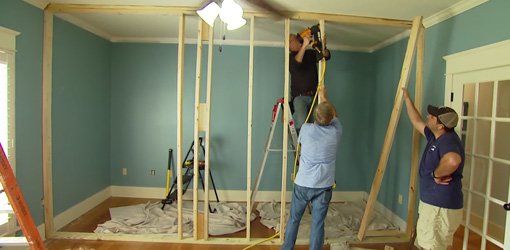Does Build A Bear Repair Bears
Building a non-load-bearing interior wall is a great way to divide a large room into two smaller rooms, add a closet to a bedroom, or add a pantry to a kitchen. Here's how to go about it.
Building a Non-Load Bearing Wall:
- Use a chalk line to mark the location for the wall on the floor.
- Remove any carpeting on the floor and moldings on the walls and ceilings where the wall will be.
- Attach the base plate for the wall to the floor using construction adhesive and fasteners.
- Use a level or plumb bob to find the location of the wall on the ceiling and mark it with a chalk line.
- Attach the two top plates to the ceiling joists.

- Toenail the studs to the top and bottom plates on 16" centers.
- Frame any door openings with a full height stud on each side of the opening and two shorter studs on the inside to support the door header beam.
- Install the header beam over the doorway.
- Cut out the bottom plate where the door is located.
- Hang drywall on the new wall.
- Install any door units in the new wall.
- Finish the drywall with drywall tape and joint compound.
- Install any moldings on the new wall.
Prime and paint the new wall, door, and moldings.
Watch this video to find out more.
Further Information
- Taking Down Walls (article)
- How to Remove a Load Bearing Wall (video)
- Kitchen Renovation Demolition and Wall Removal (video)
- Kitchen Expansion: Removing Wall Opens Up Space (video/article)
VIDEO TRANSCRIPT
Danny Lipford: The first step to building a non-load-bearing wall is determining and marking its location. Use a chalk line to ensure a perfectly straight layout line.
Where the new wall will intersect existing walls, you'll need to either remove or notch the baseboards and crown molding. If you notch it, as we did here, don't forget to allow a half-inch for drywall on either side of the stud.
We're building our wall directly on top of the existing hardwood floor, so we're applying construction adhesive before we put down the base plate. It's OK to build over a hard surface like this; but if your room has carpet, you'll probably want to remove it first.
Next, use screws or nails to secure the base plate to the floor along the layout line. The top plate should go directly above the base, so use leveled studs on either end to position and support it while you nail it to the ceiling joists above.
Then a second top plate goes directly beneath the first. This prevents the first from sagging and provides additional surface to nail up crown molding later on.
We're putting two studs connected with blocking near the middle of the wall where a second new wall will intersect the first. This will allow the two walls to be securely fastened at that "T".
Now you can fill in the rest of the studs. Because these are properly marked we don't have to use a level to plumb every stud. Constructing the wall this way means that all the joints are toenailed at an angle, and a nail gun makes this much easier.
We need to include a doorway in this wall, so either side of it we'll install a pack stud, or trimmer stud, which is two two-by-fours nailed together. One is the full wall height, and the other is the interior height of the door opening.
When the two shorter pieces are positioned on the inside of the doorway they can support the header at the top of the opening. In this case, because it's non-load bearing, that consists of two two-by-fours mounted on edge at either side. Above them, shorter studs will extend to the ceiling.
At the bottom of the doorway, the bottom plate can now be cut out. The bottom side was partially cut before we installed the base, so we wouldn't damage the flooring with the saw.
With the framing complete, the drywall can be installed over the new studs. Following that, the seams are finished with joint compound before the base and crown molding are installed. Finally, the wall is ready for paint.
Does Build A Bear Repair Bears
Source: https://todayshomeowner.com/video/how-to-build-a-non-load-bearing-interior-wall/
Posted by: terryfringlose.blogspot.com

0 Response to "Does Build A Bear Repair Bears"
Post a Comment